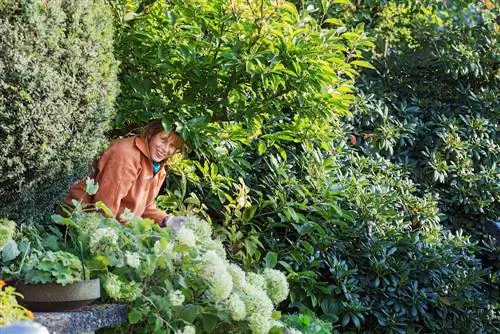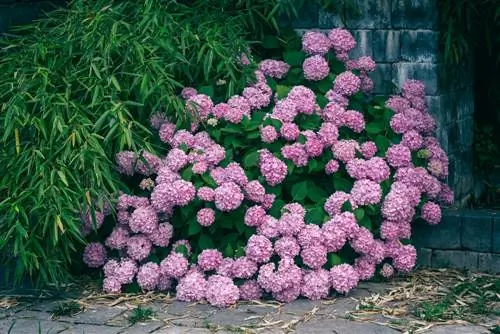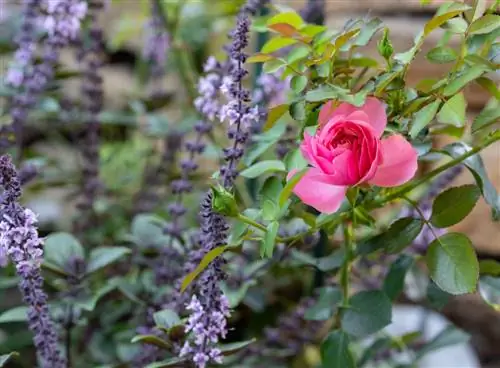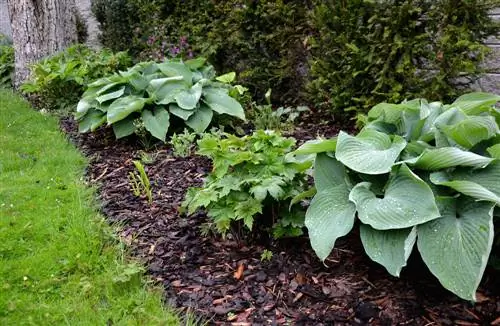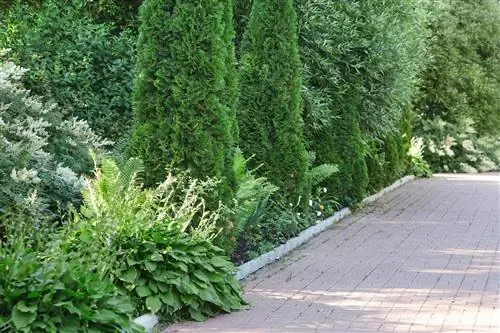- Author admin [email protected].
- Public 2023-12-16 16:46.
- Last modified 2025-01-23 11:22.
The European yew (Taxus baccata) is a coniferous tree that is popular in the garden and is primarily used for hedges and as a topiary. In addition, yews can be combined in many ways with other plant species, especially since the deep-rooted trees have few problems with root competition.
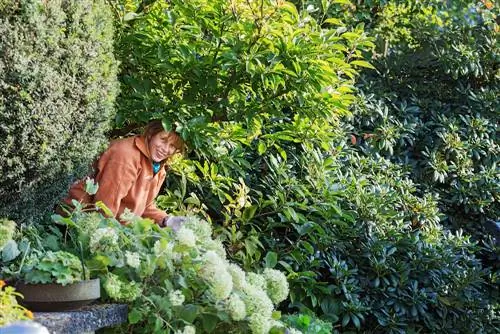
Which plants can be combined well with yew trees?
Yews can be combined in many ways with other plants, e.g. cherry laurel, thuja, spruce, pine, privet, barberry, rhododendron, hawthorn and hostas. When combining, site conditions, soil conditions and care requirements should be taken into account.
Which plants fit into a mixed hedge with yew?
Yew is evergreen, grows very densely and is therefore one of the hedge plants that offer very good privacy. This means that the conifer can also be easily combined with other conifers, as long as they have the same needs in terms of location, soil conditions and care. Suitable examples are:
- Cherry Laurel
- Thuja
- Spruce
- Pine
- Cypresses and false cypresses
But other popular hedge plants also harmonize well with yew, including deciduous and flowering shrubs:
- Privet
- Barberry
- Rhododendron
- Hawthorn
Please note, however, that yews need a lot of space to grow: young plants should be placed in a hedge at least 30 centimeters apart.
What can you plant between yew trees or near a yew tree?
The principle also applies here: you can combine anything with the yew, as long as the individual needs of the plants are met. By the way, flowering perennials and shrubs go very well with the beautiful, dark green needles of the yew tree, for example
- Rhododendron
- hydrangeas
- Viburnum (Viburnum)
- larkspur
- Daylilies
- Gloxinia
- Phlox
- Heucherella
When it comes to ornamental foliage plants, the numerous varieties of hostas (Hosta) harmonize perfectly with the yew, especially since they are also shade tolerant and prefer rather moist soil.
Should you plant yew trees near fruit trees?
This question is actually quite controversial. On the one hand, because yews are highly poisonous and children in particular might be tempted to try the red yew fruits when they are near edible fruit. There are also reports that fruit trees grow more poorly near yew hedges and produce fewer fruits.
The problem with the poisonous fruits of the yew tree can be avoided by switching to a variety without fruits ('Hillii', purely male). The second problem can only be addressed by not planting the yews near the fruit trees. In fact, it is possible that these species - roses and yews - do not harmonize with each other. However, the phenomenon has not yet been researched in more detail.
What can you use to plant a yew tree under?
Yew trees develop a strong root system over the years, but are not very sensitive to root competition and pressure. Therefore, the tree disc of a yew tree is very suitable for underplanting. For example, you can use onion flowers, which can also grow well in the shade. Hostas also work well, as do rhododendrons, hardy azaleas or hydrangeas. Other candidates would be
- Waldsteinia
- Columbines
- Storksbill
- Memorial
- fairy flowers
- Sedum
The species should be able to cope with the respective soil conditions (€22.00 on Amazon), the humidity (yews prefer it moist) and the lighting conditions (sunny? shady?).
Tip
Large selection of hostas
Hotas and yews go particularly well together, and there is also a huge selection of beautiful hosta varieties that provide variety. For example, 'Fire and Ice' has a beautiful green and white variegation, 'Sagae' has a wide, yellow edge (as does 'Aureomarginata') and 'Aurea' has beautiful, bright golden yellow leaves.'Color Glory' and 'Liberty' are also two-colored, while 'Empress Wu' scores with particularly large leaves.

